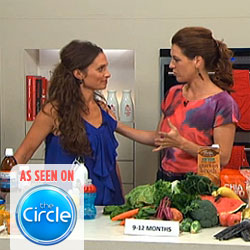 With so many questioning parents looking to ensure the health of their infants, and wondering when they should introduce solids I thought I would share some information to help guide you. I would also love for you to watch the interview I did back in 2012 on The Circle, where I discuss how to introduce solids to your growing baby.
With so many questioning parents looking to ensure the health of their infants, and wondering when they should introduce solids I thought I would share some information to help guide you. I would also love for you to watch the interview I did back in 2012 on The Circle, where I discuss how to introduce solids to your growing baby.
When is my baby ready for solids?
I get asked this a lot! At around six months (for some children it is longer) your baby will be eager to embark on the journey of culinary delights. Please note premature food introduction before an infant is ready will not help a baby to be more settled or sleep for longer periods, and may increase the risk of developing food sensitivities. It is important to wait until your child is ready for this next stage.
Some of the usual signs that your baby is ready for solid foods are:
- Your baby has the ability to sit up well.
- Your baby seems hungrier than usual between breast or formula feeds and does not seem as content or settled after the feeds. They may also seem to drain your
- breast quickly or be frustrated during a feed.
- Your baby seems interested in food. Initially your baby will be fascinated by the ‘motions’ of a parent’s eating (whilst sitting on your lap, for example). Over the
- following few weeks, your baby will start to reach for your fork, pull at your hand and verbalise their interest.
- When you try a solid food if your baby spits the food out or simply drools, keeping the food in her mouth rather than swallowing it may still be too early for solids . Wait a couple more weeks and then try again. If your baby does spit out these initial foods, this does not mean that she does not like this particular food item or that you should try another food, it may simply mean that your child is not ready for solids.
Introduce foods one at a time:
A good rule of thumb is to introduce new foods one at a time. Allow at least 5-7 days before adding additional items to your child’s menu. Giving a larger amount of a single food at a meal-time rather than small amounts of several foods will allow your baby’s digestive system time to assimilate.
By introducing foods one at a time your child will also be less likely to have a reaction. It has been proven that a small amount of a new food is more likely to induce an allergic reaction than a larger amount.
Allergies:
Allergies in Children – some stats:
- The top eight allergens responsible for 90% of food-related allergic reactions are milk, wheat, soy, eggs, peanuts, tree nuts, fish and shellfish.
- Up to 40% of children in Australia and New Zealand are affected by allergic disorders some time during life.
Risk factors for developing allergic disease include:
- Family history of allergic disease
- Introduction of cow’s milk or soy milk formula before 3–4 months of age (an increased risk for eczema and food allergy)
- Introduction of solid foods before 3–4 months of age (an increased risk for eczema and food allergy)
- Passive exposure to cigarette smoke (a risk for increased respiratory symptoms)
- Lowered immunity (decreased exposure to germs and increased exposure to antibiotics and environmental toxins)
What Foods Should I Introduce First?
Lots parents feel urgent to start their babies on rice formula as their first food. I’d encourage you to have a read of my Which Foods When eBook (an extracted chapter from Well Adjusted Babies – Second Edition) where I discuss the benefits of starting with certain fruits, vegetables, fats and proteins prior to grains.
My research over the last two decades has led me to believe we do well to keep grains and dairy to a minimum in our day regardless of our age and it is wise to always source the highest quality food sources whenever possible.
In the Which Foods When chapter of Well Adjusted Babies (or the Which Foods When eBook, an extracted chapter) I outline an ideal progression of first foods and the best ages to introduce them based on digestive strength.
For the latest version of the Which Foods When Chart (with an additional 30 foods) you can purchase that below.
All of these first foods are of course best left until after you have introduced a high quality probiotic for a number of weeks prior to introducing solids to help support digestive strength, and yes for those of you who know my work, you know that I always recommend probiotics during pregnancy and straight up for your newborn after birth. These are offered either directly into your babies mouth prior to nipple insertion at least once a day (in addition to mothers taking a probiotic) or into your newborns formula if not breastfeeding. If you haven’t been doing this please don’t be alarmed just grab a high quality probiotic from your health care provider and start today.
For additional information and guidance on probiotics and nutritional advice you can also refer to my Ten Best Nutritional Tips eBook (an extracted chapter from Well Adjusted Babies) and for guidance on formulas please see my Best Formula Options eBook.
For those parents who have already introduced some fruits, vegetables, fats and proteins as per our updated guide, and are eager to introduce a rice cereal recipe – here’s a super wholesome way to prepare and create rice cereal at home – much more nutritious than the purchased varieties! Please click here for recipe post.
Jennifer Barham-Floreani
(Bach. Chiropractic, Bach. App Clinical Science
Registered internationally, no longer practicing as a chiropractor in Australia.)
. . . . .


 With so many questioning parents looking to ensure the health of their infants, and wondering when they should introduce solids I thought I would share some information to help guide you. I would also love for you to watch the interview I did back in 2012 on The Circle, where I discuss how to introduce solids to your growing baby.
With so many questioning parents looking to ensure the health of their infants, and wondering when they should introduce solids I thought I would share some information to help guide you. I would also love for you to watch the interview I did back in 2012 on The Circle, where I discuss how to introduce solids to your growing baby.

